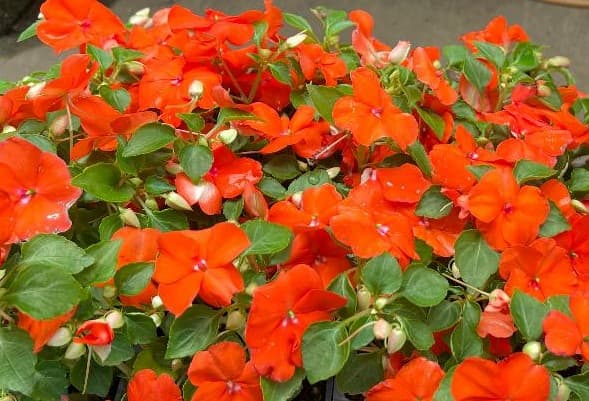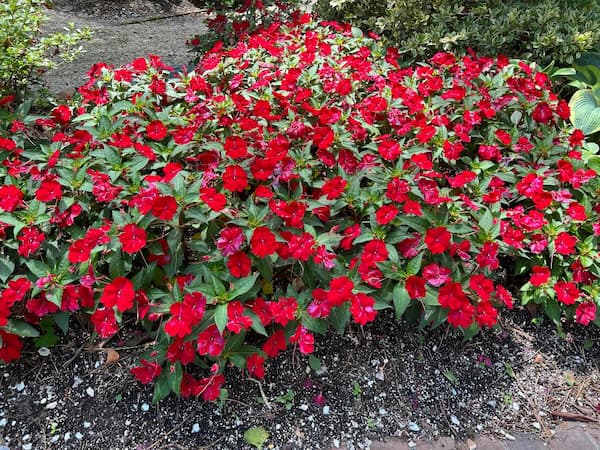How to Grow Impatiens Flowers

About Growing Impatiens Plants in Your Home Flower Garden
If you are looking for shade lovers, Impatiens plants are for you. The plants are native to Africa, Eurasia, and New Guinea. They do well in the shady parts of your yard. They make excellent indoor houseplants and are very showy in hanging baskets. Also, try them as bedding plants on the northern side of homes, sheds, and buildings. Impatiens plants have glossy, attractive leaves which you will enjoy when the plants are not in bloom. Try growing Impatiens flowers almost anywhere where the sun doesn’t shine. So, they won’t disappoint you.
Growing Impatiens indoors is very popular. As houseplants, Impatiens are fun to grow. Whether you are growing Impatiens indoors or out, they are easy to grow. Plants are compact. and will brighten up your home in winter. You can take your pick of a wide variety of colors, and some bi-colored varieties.
Did you know? Impatiens are also called “Touch-Me-Not’s and Snapweed”. Why? Because water builds up in the seed walls and can burst when touched, spraying seeds all over.
Here’s a little-known fact: Impatiens are actually tender perennial plants. However, almost everyone grows them as annuals. They are not hardy plants. And, because they are killed by a frost or freeze, people just assume they are annuals.
Impatient plants are deer resistant. This is due to the bitter taste of the leaves.
Plant Specifications
Flower Colors: A wide variety of colors including orange, pink, red, purple, white, and yellow.
Flowers Bloom: Late summer through Fall.
Plant Height: Six to 36 inches tall.
Native to: Africa, Eurasia, and New Guinea.
Light Requirements: Partial to full shade.
Ideal Soil pH: 5.5 – 7.5.
Hardiness Zone: 10 – 11.
Toxicity: This plant and all of its parts are not toxic.
Botanical Name: Impatiens
Other Names: Busy Lizzy, Touch-Me-Nots, and Snapweed.
Are Impatiens Plants Edible?
YES!! All parts of Impatiens plants are edible.
Flowers, seeds, stems, leaves, and oil from the plant is edible. The leaves have a bitter taste. So, it is seldom used in recipes. The flowers have a sweet taste. Use them in salads, soups, and stews. Flowers decorate cakes and drinks, too. The seeds taste a little like walnuts or butternut.
Caution: Consume Impatiens plants in small quantities. Consuming large amounts at one time can cause stomach aches and diarrhea.
Medicinal Uses for Impatiens Plants
Impatiens plants have been used for a variety of medicinal applications. It is used to treat skin disorders. The juice cures warts and is a treatment for snake bites. Some cultures use the flowers to treat burns. And in Asia, it is used for rheumatism, and even as a treatment for fractures.
Light Requirements
The majority of shade-loving plants are grown for their attractive foliage. Impatiens plants are grown for tier foliage, too. But, It is an uncommon shade lover as it produces a profusion of colorful flowers. These bloomers produce masses of color to brighten your day all season long.
Impatiens Plant Propagation
Impatiens are grown from seed, requiring both light and heat to germinate. Sow Impatiens seeds into trays or peat pots, covering with 1/8″ of seed starter soil. Use a germination mat or place them on top of a warm appliance. They are best started indoors since seedling plants have a long development period.
Also, you can easily root cuttings from established plants. Once your plant is established, you can make cuttings for baskets and containers for all of your friends!
Days to Germination: 10 – 20 days.

Light Requirements
Impatiens plants grow best in partial shade to full shade. As a result, they are great candidates of indoor plants any time of the year, and to add color to your shade garden.
In cooler regions, the plants can be grown in full sunlight. In warmer regions, they wilt under the warm or hot summer sun.
How to Grow Impatiens Flower Plants
The plants prefer rich, moist (not wet) soil that drains well. Water them regularly. Do not let them dry out. For plants grown in hanging baskets and other containers, check the soil daily. And, you may need to give them a drink every day in hot, dry weather. Importantly, if you are planning a trip away from home, have a neighbor or friend check on and water the plants, as needed.
Add a general-purpose fertilizer once a month. In containers, pots, and baskets, water every 3-4 weeks with a liquid fertilizer in place of dry fertilizers. You can also sue fertilizer spikes for your container plants.
The final spacing in the garden is 12-18 inches apart. The plant tolerates a little crowding.
Impatiens are susceptible to frost. Bring them indoors before Jack Frost visits your garden.
Leaf drop can be an occasional problem if grown in too much shade. It may also occur when bringing the plants inside in the Fall. To mitigate this problem, provide more indirect sunlight.

How to Grow Impatiens in Hanging Baskets and Containers
Impatiens plants look absolutely stunning in hanging baskets below porch eaves, and indoors from hooks in the ceiling. They look great in flowerpots and containers on your patio or deck, too. The only downside of hanging a basket full of Impatiens indoors, is the profuse blooms drop to the floor in big numbers as the flower dies off. But, the benefit of the pretty flowers blooming inside of your home is well worth the extra clean-up effort.
Like any container-grown plant, they need a little extra care and attention. Here’s how:
- It is important to have a drain hole to allow excess water to drain from the pot. Fortunately, most hanging baskets on the market have a saucer attached to the bottom of the pot of the hanging basket.
- Keep an eye on the moisture level. Outdoors, check the plants every day or two, especially in extended periods of hot, dry weather. Indoor plants need watering far less frequently. Keep the soil moist, but not wet. It is okay to let the top of the soil begin to dry between watering. When watering the plants, thoroughly wet the soil. Excess water will drain through the hole in the bottom of the flowerpot.
- Nutrients in a flowerpot are limited. So, use fertilizer spikes to feed the plants. Or, apply a light solution of liquid fertilizer once a month.
- Select a shaded or partly shaded location on your deck. For indoor plants, place them in indirect sunlight.
Important Garden Tip: If you go away from home for a few days. ask a neighbor or a family member to check on your Impatiens plants and water them, as needed.
Insects and Plant Disease
Impatiens plants experience occasional problems with aphids and mites. Use insecticidal soaps and repellents.
Downy mildew, fungal and viral diseases ae common. If you believe it is or could be a fungal disease, treat the plants as soon as you spot a problem with a fungicide. There is no cure for viral disease.
Also see: Plant Problems – Identify the causes and find the cures.
Pruning Impatiens Plants
Keep an eye out for dead, sickly, or diseased leaves and stem. Then, remove them as soon as you spot them.
In mid-summer, the plants often get leggy. Trim the stems back by 1/3 to 1/2. This pruning encourages them to grow bushier. Also, tit promotes a new flush of flower blooms.
Overwintering Impatiens Plants
Impatiens are tropical perennial plants that are killed by a frost of freeze. So, they are considered a perennial only in areas that do not see a frost or freeze.
In all other regions they are considered an annual and are grown as an annual.
Related Articles
Also, people who read this article will like:
How to Grow Impatiens – by Garden Hobbies
Please support our site. Shop for:
- rmmatthews100@hotmail.com
- 585-721-6528
- Rochester, NY
©1999-2024 GardenersNet.Com, All Rights Reserved

